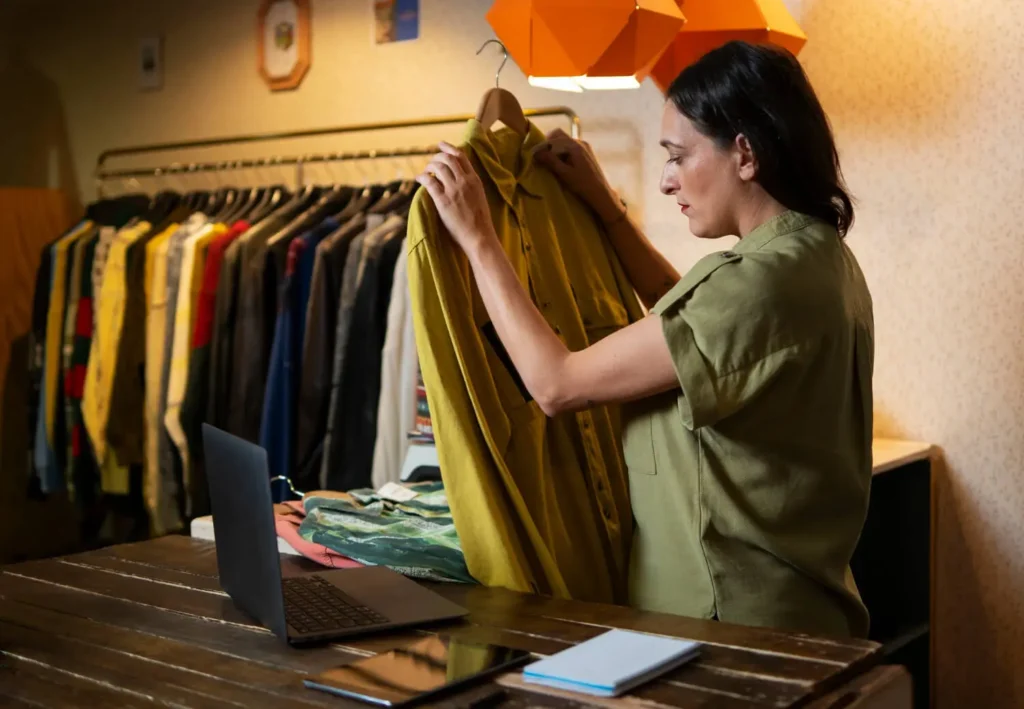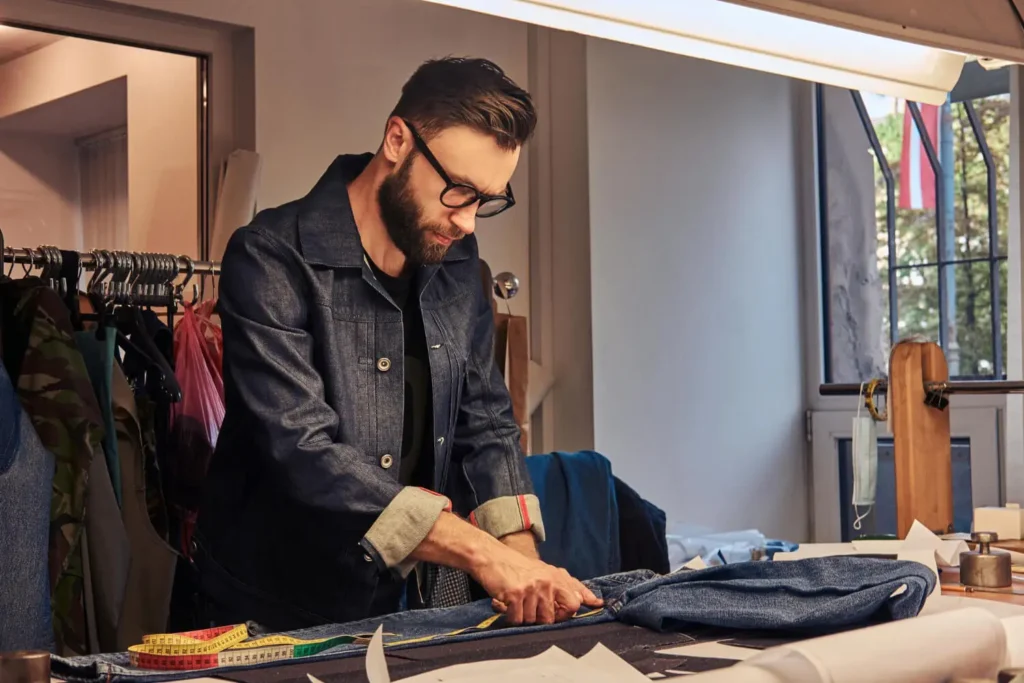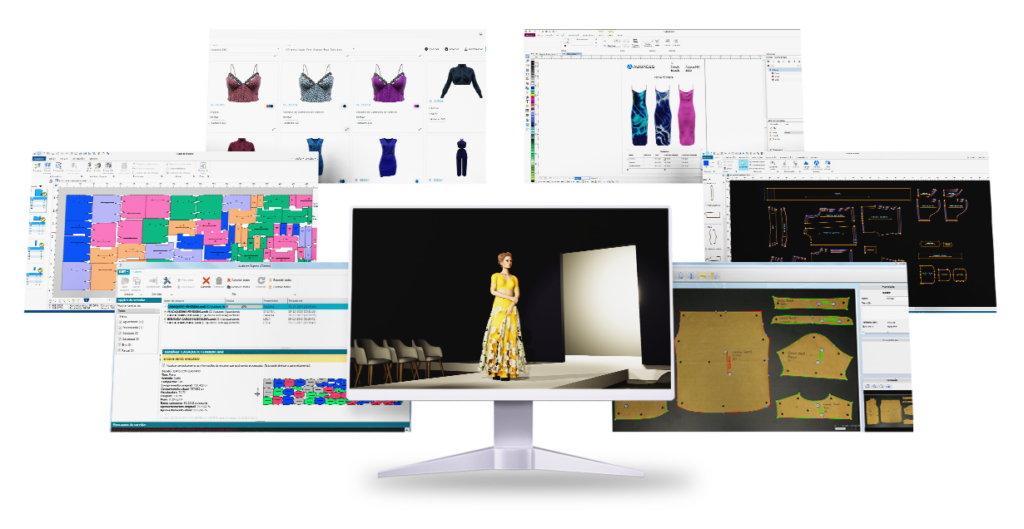Summary
- From design to production and retail, the fashion industry has a massive impact worldwide.
- Global clothing companies are fundamental in shaping economies through the power of technology.
- Experience the future of the fashion industry with Audaces360 solutions. Sign up for your free trial today!
The fashion industry is a powerful force in the global economy. It inspires trends, influences culture, and drives creativity.
But what exactly is the fashion industry, and what makes it so important? It’s not just about the clothes we wear. It’s about the trillions of dollars that flow through this sector every year.
In this text, we will explore its core elements and how it operates. We hope this provides a clearer understanding of how fashion companies impact millions of people every day.
Happy reading!
Sumário
What is the importance of the fashion industry in the world?
The fashion industry is vital to the global economy. It connects people, cultures, and ideas. It influences what we wear, how we express ourselves, and how we see the world.
These businesses play a big role in global supply chains. They need raw materials, manufacturing, and distribution worldwide.
They also support millions of jobs across many sectors. From designers to factory workers, countless people depend on fashion for their livelihoods.
The industry also drives innovation. New designs, trends, and technology affect how fashion evolves. It’s a force in shaping modern societies, making it essential to our daily lives.
What is the fashion industry?
The fashion industry is a global sector that creates and sells clothing, accessories, and footwear. It involves the design, production, and sale of products.
The industry includes both high-end fashion and mass-market brands. It’s constantly changing, driven by new trends and consumer preferences.
International trade is very important in the fashion industry. Countries produce clothing and textiles and sell them around the world.
The exchange of goods is an essential part of this economy. Fashion companies depend on it to source materials and reach global markets.
Learn more: Find out how futuristic fashion is revolutionizing the industry with technology
How much is the fashion industry worth?

The fashion industry is worth trillions of dollars. It is one of the largest industries in the world, with a significant impact on global economies.
Fashion markets span across every continent, with high demand in both developed and emerging economies. This demand drives the industry’s immense financial value.
Businesses continue to grow, with rising consumer spending and increased access to global products.
The industry’s value also comes from its ability to adapt to changing trends. It’s a dynamic and constantly evolving sector.
How big is the fashion industry?
The fashion industry is massive, touching nearly every part of the globe. It involves millions of businesses and workers across various sectors.
Its reach is truly global, with companies and consumers in every corner of the world.
The rise of fast fashion has further expanded its influence, making trendy clothing more accessible to people everywhere.
From small local businesses to giant global companies, the industry’s size and scope are immense. It’s one of the most influential fields in terms of both economics and culture.
How many people are employed in the fashion industry?
Millions of people work in the fashion industry worldwide. These jobs vary from design and manufacturing to marketing and sales.
It’s one of the largest employers globally, offering a wide range of roles for people with different skills.
In addition to direct employment, the global fashion industry supports many related sectors. It relies on suppliers, logistics companies, and retailers.
This widespread impact makes fashion a key player in global employment.
Which countries produce the most clothing in the world?

The global clothing industry is a complex network involving many countries. Some nations dominate the market due to their robust manufacturing capacity and lower labor costs.
Meanwhile, China and the United States lead as the largest markets for clothing consumption.
Now, let’s take a closer look at the countries shaping the future of clothing production:
1) China
China is the largest clothing producer in the world. It has an extensive manufacturing network that produces a wide range of garments.
China’s factories can handle everything from basic items to high-end fashion.
The country’s clothing industry benefits from a large workforce and advanced technology. This combination allows China to produce clothing at a competitive price.
Learn more: How does technology in fashion impact the textile industry?
2) India
India is another major player in global clothing production. The country has a rich textile history and a large workforce.
They are famous for their cotton production, which is a key material in clothing manufacturing.
The Indian fashion industry has expanded rapidly in recent years. The country’s manufacturers supply clothing to markets worldwide, making India one of the top clothing producers.
In addition, India has a growing demand for fashion products within its own borders.
3) Bangladesh
Bangladesh is another major clothing producer in the world. It’s popular for its ready-made garment industry, which accounts for a large portion of its exports.
The country has become a hub for affordable clothing production. All because of its low labor costs and large workforce.
Factories in the country produce clothing for some of the biggest global brands. But despite its success, the country faces big challenges. They include improving working conditions and sustainability.
The documentary The True Cost portrays some of these challenges and leads clothing factory owners and consumers to deep reflection.
4) Vietnam
Vietnam is a key clothing producer in Southeast Asia. The country has seen significant growth in its textile and garment sector over the past few decades.
Vietnam exports a wide range of clothing products to markets around the world.
It’s also working towards increasing sustainability in its garment production. As a result, Vietnam is becoming an increasingly important player in the fashion industry.
Learn more: Find out how fast fashion and sustainability can coexist in the apparel industry
5) Turkey
The country is a major producer of textiles and clothing. They can produce high-quality garments, including both mass-market and luxury items.
Turkey’s textile industry has a strong foundation built on both traditional and modern techniques.
Its clothing industry benefits from a strategic location, allowing for easy access to European and Middle Eastern markets.
6) Pakistan
A large portion of Pakistan’s economy relies on the fashion industry. The country is a major cotton producer, which forms the backbone of its clothing sector.
Pakistan is also focusing on improving the efficiency and sustainability of its clothing production.
As the industry evolves, it continues to contribute to both the national economy and the global clothing market.
7) Indonesia
Indonesia is a growing player in the global clothing industry. The country has a well-established textile sector and produces a variety of items for local and international markets.
The industry benefits from a large workforce and affordable labor costs. As a result, Indonesia is a key supplier for many global fashion brands.
The Indonesian government is also working to improve the sustainability and working conditions within the country’s garment industry.
With these efforts, Indonesia could strengthen its position in the global fashion market.
How to get into the fashion industry?
Starting a business in the fashion industry can be an exciting challenge. The first step is to define your niche.
Decide what type of clothing or products you want to offer. Understanding your target audience is key to creating products that will appeal to them.
Creating a strong business plan is essential. It should include your goals, budget, and strategies for production, marketing, and sales.
Technology is an important ally for new businesses in the fashion industry. Using software for design, production, and management ensures efficiency.
It also helps you create a professional online presence through e-commerce platforms and digital marketing.
Standing out in the market often depends on how well you use technology to deliver unique, high-quality products.
Start your journey in the fashion industry with our free guide. Learn everything you need to succeed. Download now!
How is technology 5.0 transforming the fashion industry?
The fashion industry is evolving with the rise of technology 5.0. This new era blends human creativity with advanced tools like Artificial Intelligence and automation.
It focuses on improving production while keeping people and the planet in mind. Companies can now meet customer demands faster and with better quality.
Technology 5.0 brings dynamic changes to the industry. It allows brands to create personalized designs, reduce waste, and speed up processes.
This shift is not just about machines. It’s about collaboration between humans and technology. Together, they are shaping a future where fashion is more sustainable, efficient, and innovative.
Check out the main benefits that this transformation offers:
Mass customization
Mass customization is changing the way we make clothes. Technology 5.0 allows companies to create personalized products for every customer.
Instead of one-size-fits-all, people can get clothes tailored to their style and size. This is possible with solutions like 3D design and digital pattern making.
Customers can choose colors, materials, and designs, creating unique pieces. Brands can then produce these items quickly and cost-effectively.
Mass customization improves customer satisfaction and reduces waste. By producing only what is necessary, the fashion industry can minimize leftovers.
Learn more: Find out how print-on-demand clothing can help your creation
Sustainability
This is a big focus in fashion today. Innovative solutions help companies reduce their environmental impact. It enables smarter use of resources, such as water and energy, in production.
Advanced tools allow brands to track materials and ensure ethical sourcing. Digital solutions also reduce the need for paper and unnecessary waste.
With technology 5.0, fashion businesses can produce high-quality products with less harm to the planet.
Learn more: All you need to know about sustainable fashion jobs and Industry 5.0
Human-machine collaboration
Human-machine collaboration is a huge part of technology 5.0. In the fashion industry, people work alongside machines to improve creativity and efficiency.
Machines handle repetitive tasks, allowing humans to focus on design and innovation. For example, AI can use data to provide new ideas, so designers can create fresh collections.
Meanwhile, automation helps speed up production. But the human touch ensures the final product has personality.
This partnership enhances the quality of work and keeps the process balanced. Together, humans and machines are pushing the fashion industry to new heights.
Learn more: Why should your company invest in fabrication technology?
Accelerated development
Advanced technology is speeding up fashion creation and production. Solutions like 3D prototyping let designers test ideas faster. Designers can now do in days what used to take weeks.
Automation significantly improves production efficiency. Specialized machinery can cut different materials with precision and speed. This allows companies to meet tight deadlines and handle large orders.
Faster development also means brands can respond quickly to trends. They can bring new styles to market while maintaining high quality. This agility is essential in today’s fast-paced fashion world.
Boost your fashion business performance in the era of Industry 5.0

Audaces360
Now you know everything about global fashion, it’s time to discover the ultimate suite of digital solutions!
Audaces360 integrates cutting-edge digital innovations to optimize workflows in the textile and apparel industry.
It caters to companies of all sizes and types, offering the flexibility to scale with your business needs.
We developed our solutions to address the specific challenges of the industry. They streamline and accelerate your design and production processes, saving valuable time and resources.
Audaces360 boasts a comprehensive range of functionalities, including pattern making, marking, collection management, vector drawing, and 3D creation.
In addition, a fashion Artificial Intelligence to assist you along the way.
Audaces Cutting Room
Looking for complete automation? Audaces Cutting Room offers the perfect solution.
Seamlessly integrate software and machinery to maximize precision and efficiency in your fashion production.
Our experts will thoroughly assess your company’s needs and create a customized automation project.
This way you can achieve impeccable cuts on curves and details with our smart cutting machine.
Partner with a company boasting over 30 years of textile industry expertise. Click here to request your personalized project!
FAQ
The fashion industry is vital to the global economy. It connects people, cultures, and ideas. It influences what we wear, how we express ourselves, and how we see the world.
The fashion industry is a global sector that creates and sells clothing, accessories, and footwear. It involves the design, production, and sale of products.
The fashion industry is worth trillions of dollars. It is one of the largest industries in the world, with a significant impact on global economies.






